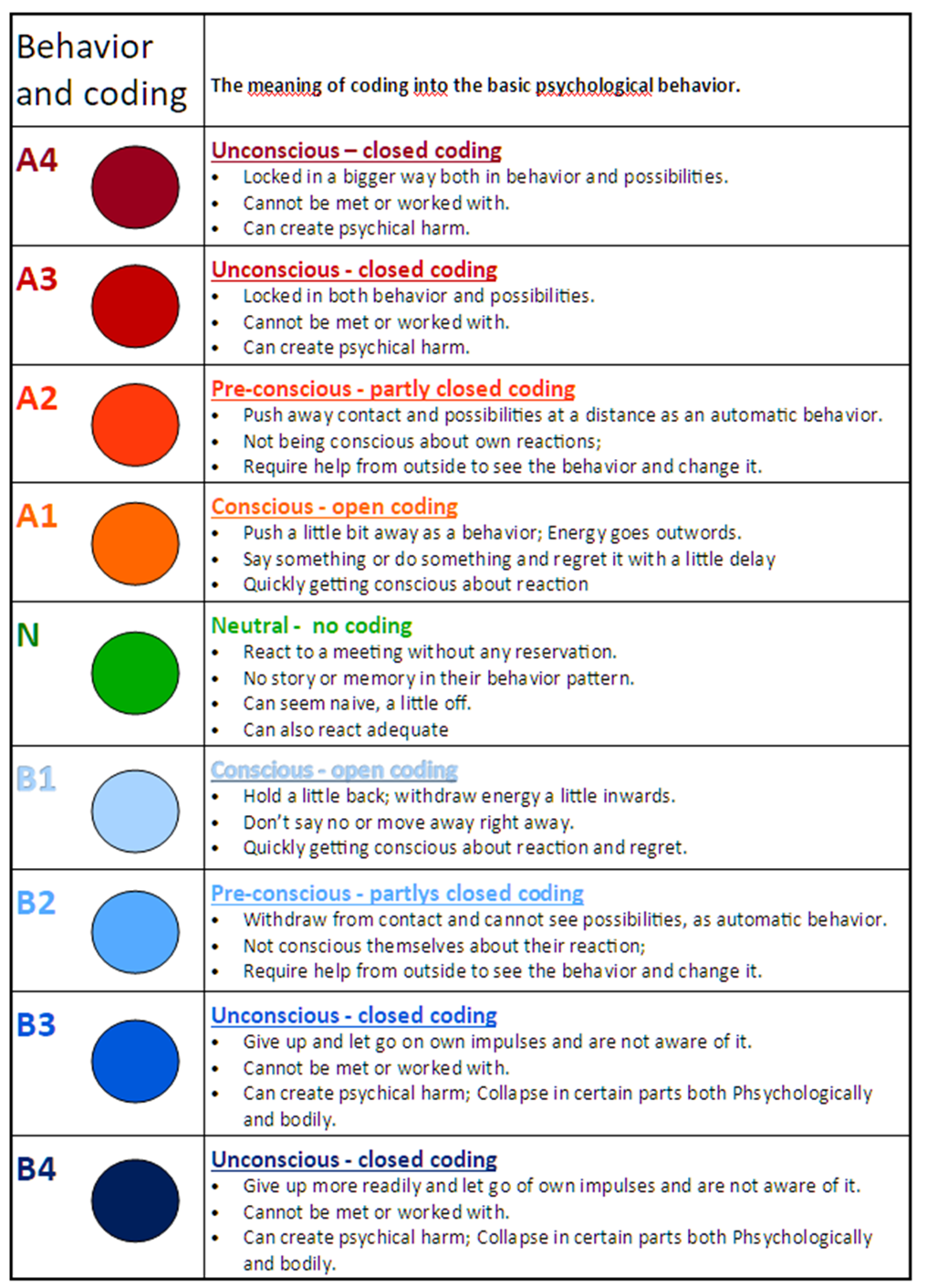Developmental trauma from a bodynamic perspective
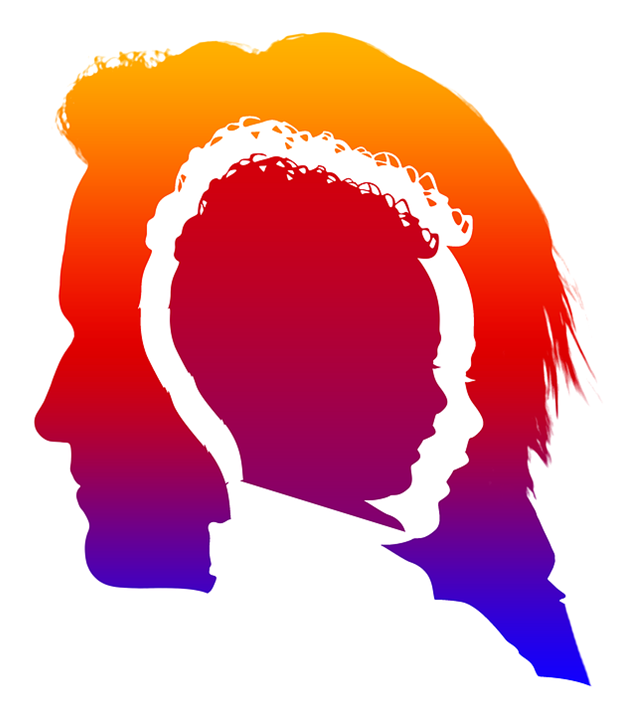 By Ditte Marcher and Lene Wisbom, March 2020, ©Bodynamic International ApS
By Ditte Marcher and Lene Wisbom, March 2020, ©Bodynamic International ApS
translated into English by Tina Janken Tage
In Bodynamic we differentiate between open and closed coding’s, developmental trauma, PTSD and Complex PTSD.
All these elements can be seen in a BODYMAP. This article will explain how developmental traumas can be seen in a Bodymap and how they show up in certain EGO-functions.
In open coding behavior, you become conscious of your actions shortly after you do them. Closed coding behavior is different. It consists of 2 types: Actions that you can gain consciousness of with the help of others, following the actions, and actions that you are unable to gain consciousness of even with the help of others.
Developmental trauma is like having an unavailable space within – ’a closed space’. It becomes an unavailable space because of your lack of ability to recognize a certain dilemma. No matter how hard you try, you cannot imagine that life can be any different, and therefore you get stuck in the same issues, again and again.
For example, when Jane enters a relationship, as soon as her boyfriend gets too close, she starts to create fights over the smallest things, in order to avoid closeness. After a while, many fights later, she decides to stop the relationship and goes into the same pattern with a new partner. Her closed coding doesn’t give her any new option to act as she feels frightened when her partner starts to come emotionally closer to her.
All the above mentioned elements are part of our EGO. The EGO consists of different layers – the conscious, pre-conscious, and the unconscious. In a state of shock, we enter the ME and act from there. Post Traumatic Stress Disorder (PTSD) is about falling out of the EGO into the ME. For example, a person goes from the more conscious part into to the survival mode part of the brain and way of being.
Complex PTSD differs in the fact that after falling out of the EGO, you fall into a state of shock. From here you try to orientate from the developmental trauma, in other words, the closed space; Total chaos!
Our patterns of experience create certain behaviors and depend on the childhood interactions with parents, siblings and key persons, and later interaction with adults outside the family, other friends and institutions.
A developmental trauma occurs when a child, during a longer period of time, constantly feels that their dignity, individuality and mutual connection are threatened. This will create specific challenges for the child in one or more EGO-functions relating to a specific developmental stage. It will also lead to the loss of already learned abilities, and the child will lose the ability to develop new skills within those EGO-functions. One or more of the 11 EGO-functions could be hit. A character structure is a defense you develop, while an EGO-function is how you act out based on that specific defense.
What characterizes a shock trauma is a sudden incident where the EGO is not able to cope with the situation due to insufficient strategies. When that happens, the EGO will shatter and the ME will take over. During our childhood, teenage years and adulthood we will all experience shock traumas that make changes to our life.
Some will go through life crisis/shock traumas, release and integrate central parts of the experience, while others will only release parts of the crisis/shock traumas. If the central parts are NOT released the experience will still affect their behavior years after the specific incident took place. The part that has not been released will still be present in our system, and the amount of that stress can be diagnosed as Post Traumatic Stress Disorder (PTSD).
EGO-functions:
A character structure is a defense you build up, while an EGO-function is how you act out based on that specific defense. So what does that mean?
In Bodynamic we operate with 7 developmental stages – they are called character structures. At each stage there are specific themes attached – for e. g. ’the right to exist’, ’the right to your needs’, ’the right to your impulses and curiosity’ etc. We can relate to the themes attached to each stage in two different ways. We can withdraw from the right, or we can push it away – both happen in contact with others.
This is where we use the EGO-function. While we as children go through a developmental theme, we learn to take ownership of our rights through the EGO-functions. For e.g. the right to Positioning yourself through your needs, or affirming your Boundaries, your Centering, your Connectedness, your Interpersonal Skills, etc. all relative to your needs.
Centering is a basic EGO-function. If you are not aware of your center or not able to start from within, the other EGO-functions will also be less functional, and they most likely need to be practiced and strengthened before Centering is possible.
An important EGO-function when building the Observing EGO is ’Cognitive Skills’. Cognitive Skills consists of ’the ability to orientate’, ’cognitive grasp’, ’understanding and integration’, ’planning’ and ’consideration’.
Some of the EGO-functions are closely intertwined. For e.g. EGO-functions like Boundaries and Energy management, Positioning and Grounding, Interpersonal Skills and Connectedness, Self Assertion and Social Balance.
Gender Skills stands alone because it relates biologically to something very deep within us and is already integrated into the other 10 EGO-functions.
How is the movement connected to the psychological behavior?
Existence:
Eg.: The muscles Longus Capitis and Longus Colli (110) are the most important muscles in the throat when we talk about ’the right to exist’, and they therefore contain important psychological functions and are present in 4 different EGO-functions.
Movement of these muscles makes several positions possible, like holding the head and stretching the neck so the head can be balanced and stabilized. Longus Capitis and Longus Colli (110) forward bend, rotate and laterally flex the head and the cervical spine.
These muscles become active before birth and will be used during a natural birth process.
I Positioning the psychological functions are:
- a) Relating to life; integrating spiritual life into physical life,
b) orientate (keeping your head cool/losing your head); to orientate oneself in the integration of spirituality, thoughts and body sensations.
Longus Capitis and Longus Colli are very sensitive and contain the most nerve endings per square centimeter than any other muscles in the body. The muscles are being used to prepare oneself to enter the world, and to be able to relate to the physical life outside without losing one’s head when meeting a new world. This also means keeping contact to an instinctive level and through that the spiritual level inside us.
A collapse in Longus Capitis and Longus Colli could lead to whiplash, and it could prevent the ability to deeply integrate an internal experience of connection between spirituality, thoughts and body sensations.
Need:
Another example could be the muscle Deltoideus, anterior part (65) which is an important muscle in the Need structure. The muscle stabilizes the shoulder joint which makes the ’reaching out’ movement possible, i.e. the child lifts the arm forward.
The movement is a flexion, an adduction, an internal rotation and it moves the arm forward.
Deltoideus, anterior part (65) is present in 2 EGO-functions, Boundaries and Interpersonal Skills:
In Boundaries the psychological functions are:
- e) making room for yourself (take place in social contacts), make room for your needs.
In Interpersonal Skills the psychological function is:
- a) reaching out – insisting in having your needs met.
The following example will show the 2 EGO-functions together;
Imagine a child lying on the stomach, pushing himself up by the arms. The movement happens from within the child and is mostly a reflex, but at the same time there is a cognitive consciousness and activity in the anterior part of the Deltoideus muscle. The movement gives the child the sensation that he can move itself from the concrete physical boundary, and the ability to make room and space for himself (this relates directly to the space between his body and the floor).
Through the first character structure, ’Existence’ the child has so far only been able to feel his boundaries physically, i.e. the skin. This develops further in the Need structure where the child can develop abilities to take and make more room for himself and for his needs.
Autonomy:
Last example is the muscle Quadratus Lumborum (11). It is a lower back muscle running from the ribs to the hips. It is used in creeping and crawling and it makes standing on leg possible (weight on one leg only).
The muscle lowers the ribs, lateral flexes the spine and lifts the hip.
It is present in the EGO-function Social Balance:
- a) balancing own needs/feelings and other people’s expectations, i.e. keep the sensation of yourself and your impulses while you mirror others.
Quadratus Lumborum is the most important muscle when keeping physical balance as it can give a clear internal sensation of connection between the upper and lower part of the body. It is important to move in a way that allows us to follow our impulses and maintain curiosity, so we can enter social contact in a more independent way. This way we can get a clear internal experience of preserving ourselves, having our own impulses and with that mirror others.
Common factors in developmental trauma
Developmental trauma is about being hit in a characterological pattern. This will disrupt one or more EGO-functions at a level where you lose already learnt abilities relating to those EGO-functions. Later in your development this will result an inability to learn new skills within those EGO-functions. As an adult, this will create ’closed spaces’ or ’holes’ in your life.
In our experience gained from working with people with developmental traumas, there are certain common factors:
- One of the factors is the more or less non-existing Observing EGO and poor Body EGO where the ’hole’ in the developmental stage lies.
- Another characteristic is the tendency to fall into hopelessness – ’no way out ’scenario– and often a low production of happinessy hormones, which makes holding on to good things in life and a joyful life very difficult.
- There is also a lack of ability to experience internal dilemmas. It is impossible to be with the good and the bad at the same time. This is a Will structure issue where life becomes black and white, all or nothing. The capability of noticing the dilemma from inside is a necessity for building the Observing EGO.
We often have a conception or an illusion of harmony, which also is a lovely thing to have in life.
We need to remember that harmony does not create progress.
The search for harmony creates progress, not harmony in itself.
Graphics inspired by Lev. Vygotsky’s theory: Zone of proximal development
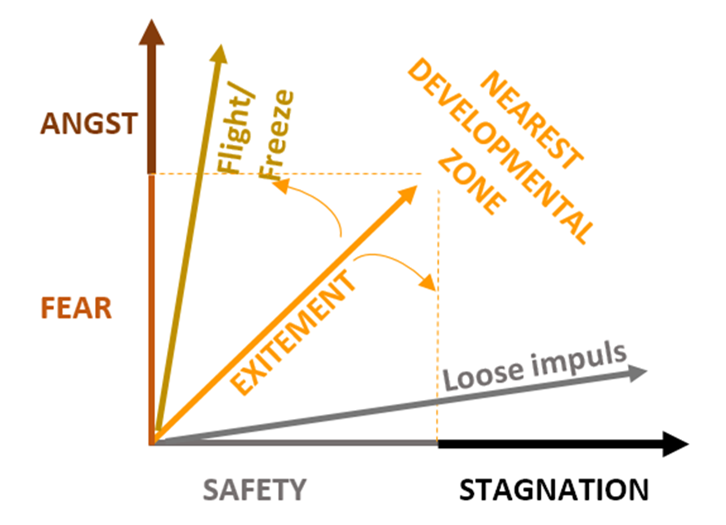
©Ditte Marcher, layout Lene Wisbom
* Learning takes place when there is a balance between challenges and security and where we can lean into support and security.
* If the challange gets too big we get too close to the instinct layer and will flee or freeze.
* If the challenge is too small we get bored and lose our impulse and concentration.
It needs to be challenging and we need to succeed.
Developmental trauma seen in an EGO-function in a BODYMAP
Our internal dilemmas in life are not always pleasant. They are nevertheless a condition for development, and this is where is becomes interesting looking at a Bodymap.
In the below examples we show developmental trauma in various EGO-functions, and most importantly WHEN the muscle answers show dilemmas indicating a potential for development.
Bodymap 1 (below) shows developmental trauma in Interpersonal Skills because of the predominantly A1 answers. In response, an A1 muscle pushes away a little, i.e. shortly after an action the person will realize his/her behavior. B muscles do not push away, but withdraw in response
The possibility for changing behavior is possible if both A and B muscles are present in the EGO-function. This creates the possibility to experience the dilemma from within, ask ourselves questions and last but not least have a choice of action.
When we look at this EGO-function we can see that all fore and upper arm muscles in the front, only have potential for the same response pattern, in this case ’pushing away’. There are NO dilemmas (A1->B1), no possibilities for withdrawing. The person can have an experience and awareness of their behavior. They can be sorry and apologize for their action, but they actually have no an alternative. They will go and do it all again next time.
So instead of being able to draw in they push. Often it is with an internal sensation of actually drawing in and pulling towards themselves. In this case they don’t understand why others perceive it as a push, and are therefore stuck in thinking ’they all leave me’.
This is what we call recurring ’loops’.
The back of the arms shows several B quality muscles (B2, B3), which will not give the person the possibility to say STOP, keep things at a distance or regulate the contact from here. This causes severe tension because where you would pull in, you push away, and when you want to keep out, you give up. In this case, because of the B2 and B3 muscles, the actions and behavior are unconscious.
The space you enter here is the ’closed room’ and there is no way out.
All character structures in Interpersonal Skills show signs of ’learning that has been lost’, and that further learning has not been possible.
It is of great interest how big a percentage of A1 answers there is in this EGO-function – a total of 72 % compared to B1 answers of 10,9 %. There are no A2 and A3 answers which indicates that the A1 behavior has nothing to play against.
Bodymap 1: Interpersonel Skills
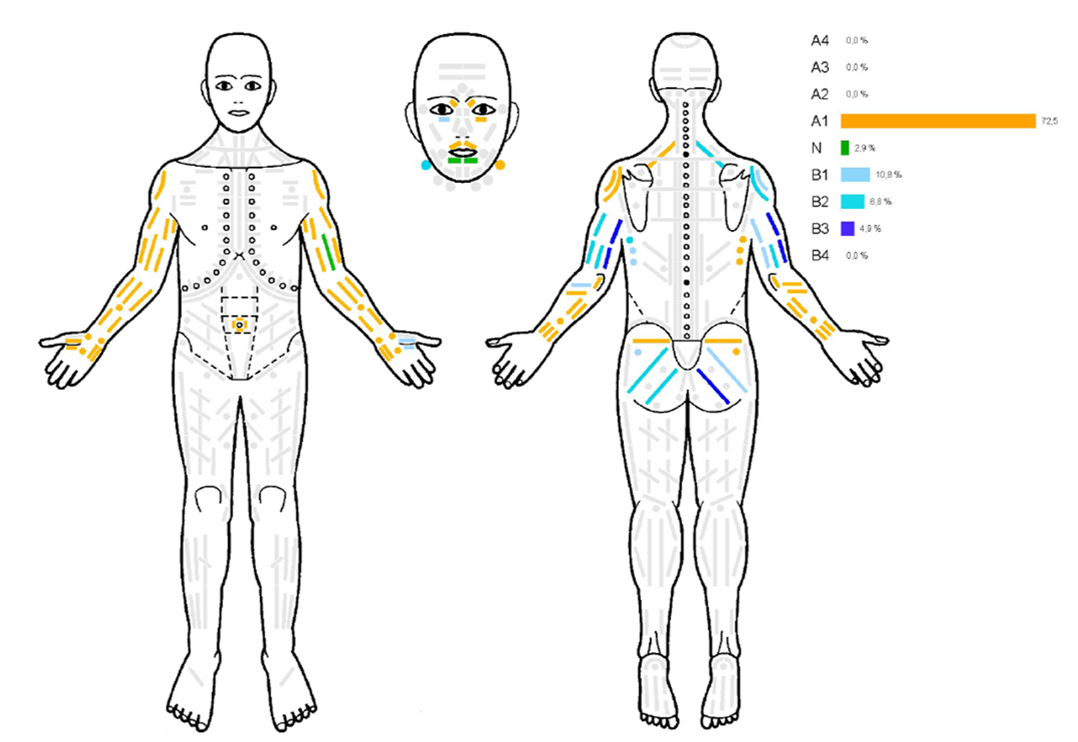
Bodymap 2 shows clearly a developmental trauma within the EGO-function Connectedness. There are no B answers and therefore only one pattern of behavior available, in this case ’pushing and closing’. There are 81,9 % A1 answers, 13,6 % A2 answers and 4,5 % Neutral (green) answers. This leaves us with the feeling that something has not been lived, in other words, a ’so what’ response.
The fact that you are conscious of your actions/behavior, does not mean that you will change your actions/behavior.
Bodymap 2 is an example of a ’closed space’ – ’that is the way life is’!
Bodymap 2: Connectedness
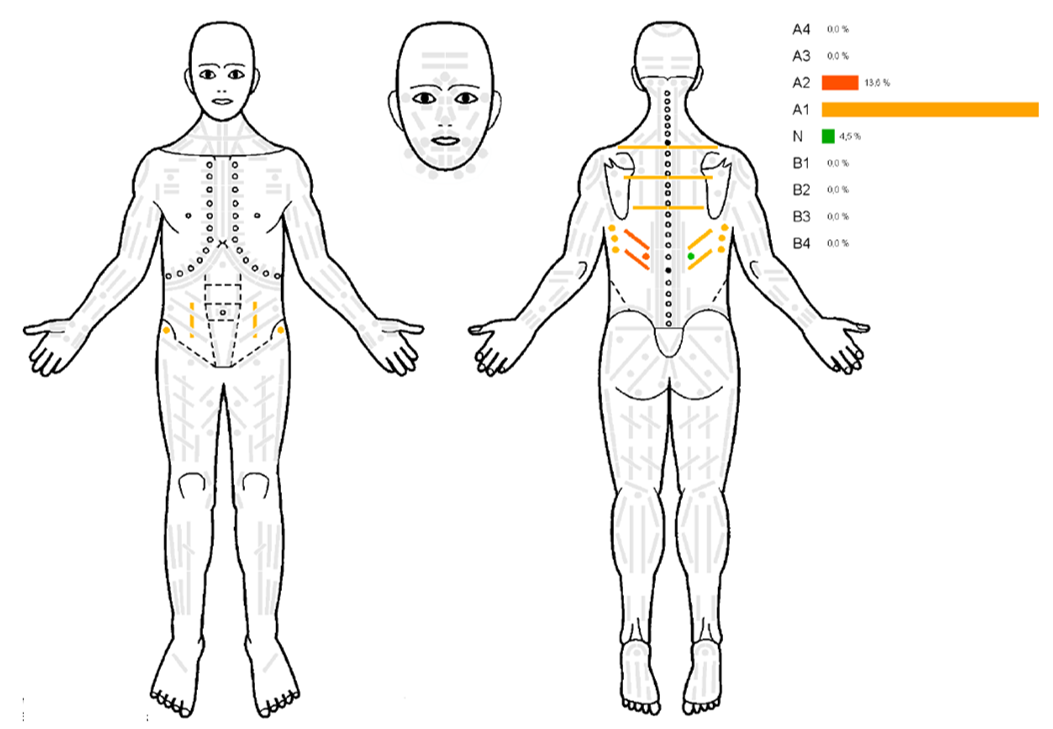
Bodymap 3 and the EGO-function Gender Skills shows a balance between A and B answers, i.e. balance between pushing and withdrawing, closing and giving up. It clearly shows a coding system where there is a workable interaction between the red (A) and blue (B) answers. This creates internal dilemmas from which you will raise questions towards yourself. A small portion of the answers in Bodymap 3 (A2 and B2) are pre-conscious, i.e. a partly closed coding. There are also a lot of resources available in defenses which can be used to turn the pre-conscious more conscious. This will give the person possibilities for making changes to their behavior.
The internal conflicts contain a wish for making changes and a conscious experience of – “life can be different”, ”there are other possibilities”. So even though it can be tough it creates a bigger picture of the world also in the interaction with other people.
Bodymap 3: Gender Skills
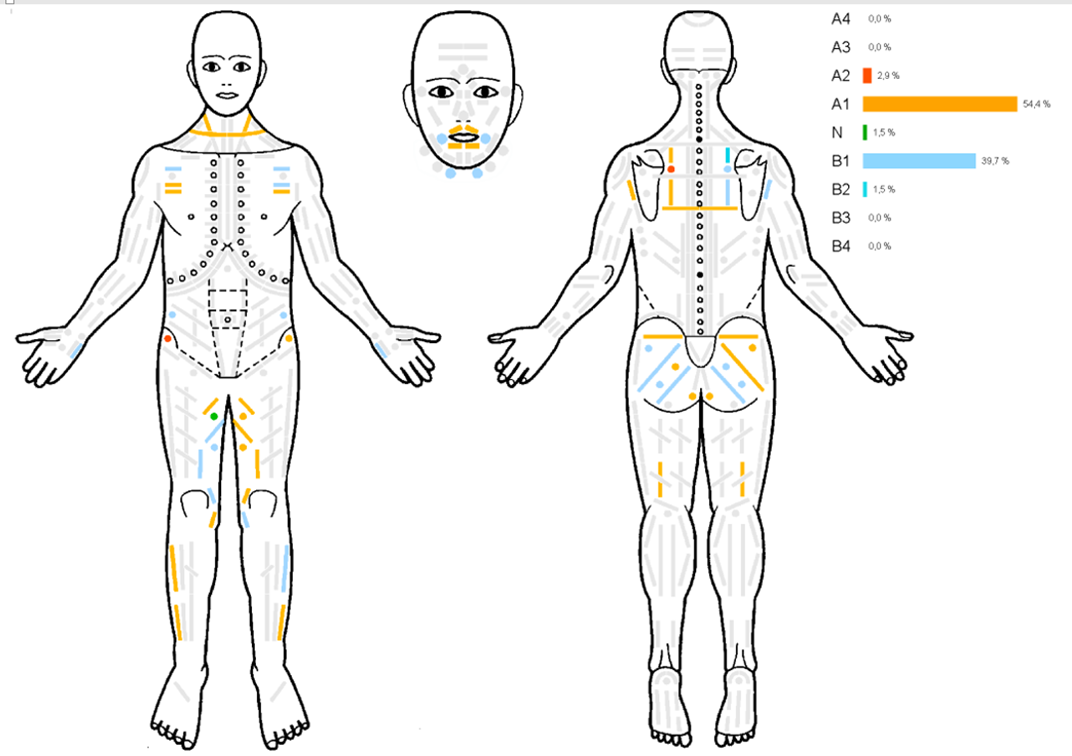
Final comments:
In Bodynamic we have started collecting Bodymaps from all over the world. The aim is to study the EGO-functions and to look into any culturally recognizable relationships.
We have noticed that within the last 10-15 years, Bodymap answers have changed. They now have a tendency to be lighter in colors and with less internal dilemmas. We are not certain what this indicates or how it can be interpreted, but it is something of great interest to us and something that we will investigate further.
Download article as PDF
Below you find the different coding’s and colors used in Bodymaps. The schedule can be used for deepening the understanding of the significance of the coding’s in relation to the basic psychological behavior
